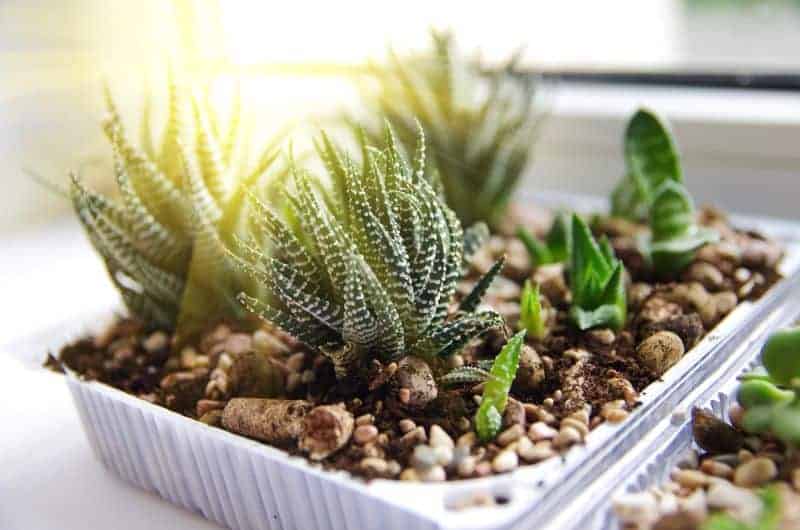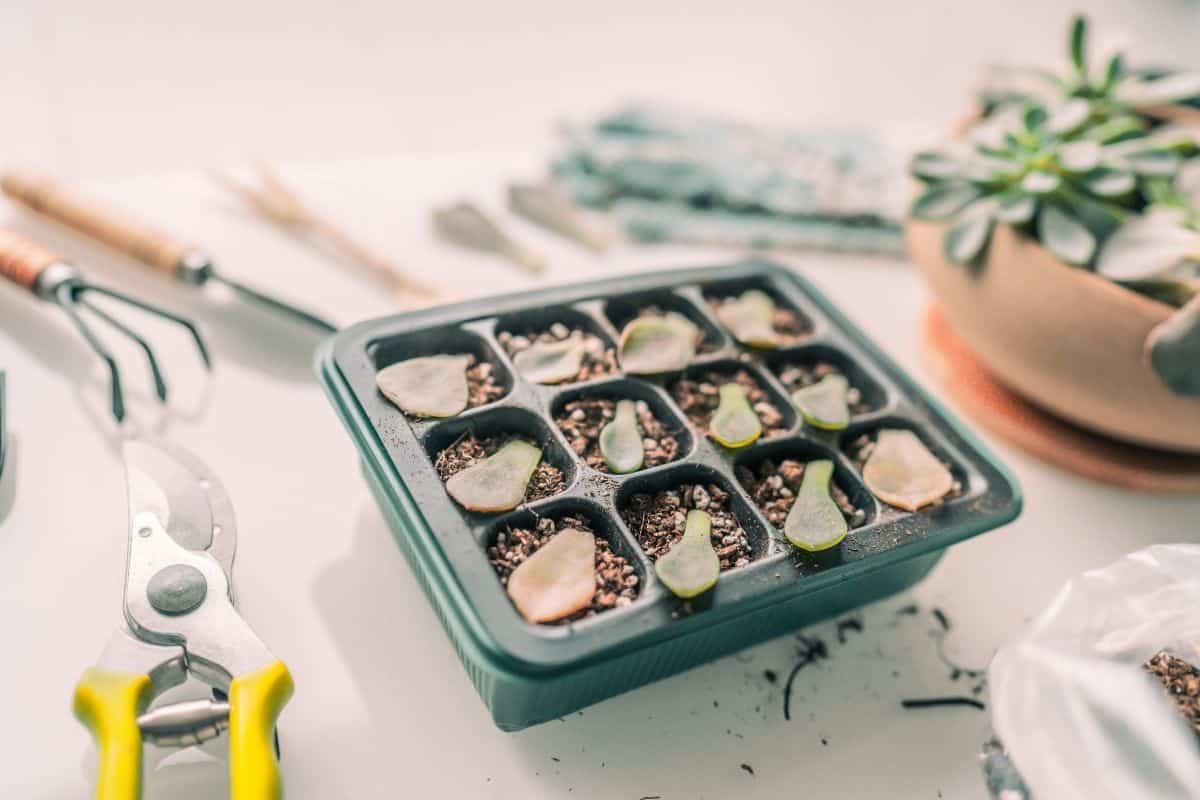What do I do now that I’ve got a succulent?

Congratulations on your recent acquisition! We’re sure you two will get along just fine. Here are some general tips for succulents. Please note that while this information is accurate for many of the plants you will encounter, certain species require specialized care. Whenever you bring home a new plant, you should do a little research on how to care for that specific species of succulent or cacti. When it comes to raising succulents, knowledge is power!
Related Article: How Do Succulents Reproduce
Succulent Soil

As you know, most succulents are found in arid or desert environments. They have different soil requirements than say, cherry trees or orchids. The primary objective of succulent soil is to achieve drainage. As air is a necessary component of root growth and health, a soil that allows water to pass through it is crucial. This is especially true for succulents which are not accustomed to large amount of water or wet soils.
An example of succulent soil composition might be:
2 parts of regular potting soil
1 part perlite
1 part coarse sand or gravel
This is not a mandatory formula – these hardy plants should do well almost anywhere as long as they have proper drainage. To that end, only plant in pots with a drainage hole. There is a common misconception that leads people to line the bottom of their pots with gravel or rocks. This does not actually make up for the lack of a drainage hole – it actually keeps water near the roots! Read this article about succulent soil for more info.
For a commercial alternative, most cactus soils work wonderfully for other succulents too!
Many people recommend organic soil additions such as sphagnum moss. Moss serves to hold water, which is generally not what succulents want. Remember that we are seeking to emulate the plant’s natural habitat. There is very little organic matter in the soils of deserts!
Succulent Water

This is the trickiest part of caring for succulents, and indeed, most plants. It is tempting to show your plant a little love by giving it some water as you fawn over it daily. But please, ladies and gentlemen, restrain yourselves. While you may have the best intentions, you will only serve to smother your plant. Succulents prefer a more hands-off approach to their care, so the less attention you give them, the better they’ll do. Feel free to admire them from a distance but try to keep the hands-on affection to a minimum.
No products found.
It’s hard to give an exact time frame such as water your plant every Sunday, as each species and even individual plant has its own needs. A good rule of thumb, however, is to water your succulents once every two weeks. But keep an eye on them! You may find that they begin to wilt. If so, water them a little more frequently. If you notice leaves or stems starting to turn brown or black, they might be suffering rot. You’re probably drowning the roots. Cut back a little bit.
There are times that you may find yourself watering your succulents more or less frequently. During hot weather, or if you have your succulents in bright sunlight, you may need to water them more often than you would during periods of chilly or overcast weather. Succulents planted in darker colored pots may also experience more evaporation than those in light-colored pots. If your area is experiencing periods of extreme temperatures, you may need to pay closer attention to your succulents until the weather returns to normal.
If you’re unsure of whether you should water your plant, try checking the moisture of the soil. Stick your finger into the soil and if it feels moist an inch or so beneath the surface, it’s not ready to be watered yet. It’s crucial that you measure below the surface, as the surface may feel dry to the touch while the soil further down is still soaked.
There are several methods of watering. It is usually fine to pour water near the base of the plant, as you would with any other plant. If you don’t want to disturb new or fragile plants, try using a water stone. That is a stone on which you pour water which spills off onto the roots of nearby plants. Some succulents also like to be misted. Misting is especially helpful if you’re growing succulents from seeds as many species produce tiny seeds that can easily be washed away.
If your plant looks unwell, don’t panic! Remember why we picked succulents? They’re pretty but tough. They can survive a beginner gardener. Experiment with different watering regimes. It’s okay if they lose a couple of leaves along the way, they’ll be better for it once you figure out what makes them happy. Mastering the water needs of succulents is an accomplishment to be proud of, so don’t be afraid to experiment while you’re still learning how to care for your succulents.
Remember, the more you know about the individual succulent species in your garden the better you’ll be able to care for them. It only takes a few minutes of research when you bring a new plant home to make sure you’re giving it the care it prefers. As you gain more experience with succulent gardening, you’ll be better able to predict what type of care each plant needs. No matter how experienced you are, however, it doesn’t hurt to keep learning!
Succulent Sun

An assumption that many beginners fall prey to is that there is no such thing as too much sunlight. On the contrary, despite being characterized as “desert plants”, succulents are subject to sunburn (though not in the same way that we are!). Usually, an average of 8 hours a day of sunlight is enough for these plants.
Sunburn is usually not a serious issue and can be rectified fairly easily. Symptoms often manifest themselves as discoloration or brown spots, in addition to wilting. Discoloration may range from a light brown to black depending on the severity of the burns.
If you are afraid that your plant has sunburn, try moving it further from the window or to a window facing another direction (if inside) or place it in a place that has partial shade during the day (like under another plant if outside).
Unfortunately, if your plant has been sunburned, there’s no way to fix the damage. The discoloration is there to stay, but it will not cause any lasting damage to your plant’s health. Sunburn is unsightly, but your succulents will live through it. With time, the sunburned parts of your plant will be replaced with new growth and you’ll never even know it happened. If you can’t wait for nature to take care of it, you can always prune off the burned sections of the plant.
Of course, the opposite problem is more common – not enough light. One train of thought is that many succulents do better outside (depending on the season), and so repositioning your plant into some fresh air may yield positive results. For those that prefer to keep their plants inside (and better defended from pests), grow lamps are good, if costly, choice.
Note:
– South-facing windows are optimal (if you are in the Northern Hemisphere).
– Some succulents go through seasonal periods of dormancy and growth and require different care methods!
One way to tell if your succulents aren’t receiving enough sunlight is their shape. As succulents grow without sufficient light, they tend to grow more in height, in an attempt to reach more light, rather than producing an abundance of new leaves. This stretching is called etiolation. Like sunburn, etiolation isn’t harmful to your succulents, but it can be unsightly. There’s also no way to really fix the problem unless you trim the plant back. The benefit of trimming your etiolated plant is that you can replant the cutting. Be sure to adjust the light levels after trimming to prevent the plant from becoming stretched out again!
Succulent Propagation

Once you’ve developed your green thumb and know how to care for succulents and cacti, you can move on to expanding your collection through propagation. Simply put, propagation is how succulents reproduce. Like every other aspect of succulent care, succulent propagation is relatively simple.
As with most plants, succulents can be grown from seeds, but most gardeners opt for other methods of propagation. Growing succulents from seed is a time-consuming process that is best suited for more patient succulent lovers.
Additionally, seeds are somewhat unpredictable. When you propagate a succulent with a cutting, you already know what the mature plant will look like based on the leaf or stem that was removed. With seeds, you never quite know what you’re going to get until the seedlings are big enough to see. This can result in some interesting surprises.
The way most gardeners choose to propagate their succulents is with cuttings. As previously mentioned, either stem or leaf cuttings can be taken. It will depend on what type of succulent you have as to whether you should use leaf or stem cuttings. Remember, research is a succulent gardener’s best friend!
To take a leaf cutting from a mature succulent, simply snip or break off a leaf as close to the base as possible. For stem or branch cuttings, you’ll want to cut off enough of your succulent to ensure the success of your cutting. In other words, don’t snip off the very top of the plant if it’s not healthy. There is no perfect place to make your cut, but you want to include as much new growth as possible. For more information on propagating cuttings, check out this article. Always use clean, sharp shears or scissors to take your cuttings!
Once you have your cuttings, you’ll need to wait several days or a week to allow the cut to callous. You may be excited to get your cutting planted in its new home but allowing the cut to callous will prevent infection by bacteria or fungus, so be patient. Once the cut is calloused, it can be placed in the soil. You’ll have to wait several weeks before watering your cutting since it doesn’t have any roots yet, but all of your patience will soon pay off when you see your new succulent sprouting roots.
Some succulent species also produce offsets which are especially easy to propagate. Sometimes referred to as pups, offshoots, or plantlets, these little succulents are basically ready to go once separated from the mother plant. Offsets can be removed either with gentle maneuvering or by cutting it from the base of the mature plant. As with cuttings, it’s best to allow the offset to dry out and callous before replanting.
No matter which way you choose to propagate your succulents, once they’ve started developing roots, their care is similar to that of mature plants. Now that you’re knowledgeable on how to care for succulents, go forth and grow!
You Might Also Like:


Cat
I wanted to say thank you for taking time to explain the things you did. I love succulents, but have NO luck , well almost no luck getting them to grow. So , thanks again!